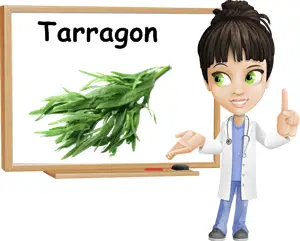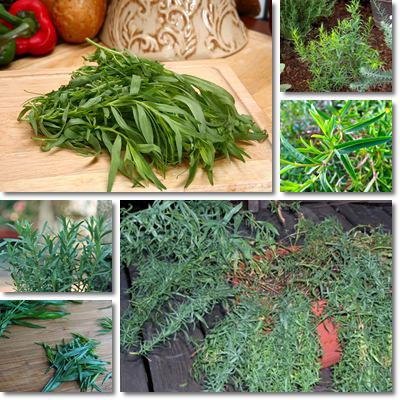A favorite of the French and Mediterranean cuisines, tarragon (Artemisia dracunculus) is both a spice and a medicinal herb. The herb is an extraordinary source of vitamins and minerals and boasts a strong antibacterial, anti-inflammatory and antioxidant activity. It is rich in B vitamins and contains great amounts of vitamins A and C, both of which boost immunity and speed recovery in cases of colds, flue and other viral infections. In addition to this, tarragon has an amazing calcium content and provides us with incredible amounts of copper and manganese, two minerals known to delay aging signs and help us look young, healthy and fresh. Even more, it contributes to cardiovascular health as a result of its high magnesium and potassium content.
What does tarragon look like?
Tarragon is a bush-like, 60 cm-1 meter tall, green garden plant. It has tiny, blade-like leaves that look quite similar to rosemary, but are softer. When dried, the leaves acquire a greenish-grey tint. There are two main varieties of tarragon:
- French tarragon (the more aromatic variety).
- Russian tarragon (quite resilient to drought and poor soil quality, but has a poor aroma).

French vs Russian tarragon
How to tell the difference between French and Russian tarragon? Hint: taste a leaf or two. If you feel your tongue a bit numb after chewing on one or two leaves, then it’s French tarragon. Russian tarragon is not quite as flavorful, while the plant is taller.
What does tarragon taste and smell like?
The leaves smell a bit like lemon and licorice and have an anise-like flavor. This is because the plant contains an aromatic oil called estragole, also predominant in anise and responsible for this particular taste. The smell of tarragon is reminiscent of that of leaves, a sort of green, earthy smell.
Tarragon is one healthy herb and regular consumption contributes immensely to keeping us in good health. Despite the fact that we don’t eat it in great amounts like we would spinach or apples, it is so nutrient-dense that even the smallest amounts help us meet our daily recommended intake of several essential vitamins and dietary minerals.

Benefits and uses of Tarragon
What makes tarragon so healthy? See below the top 9 reasons why tarragon is good for you:
Lower blood sugar levels
According to research, certain polyphenolic compounds in tarragon can help lower high blood sugar (glucose) levels. This prevents blood sugar highs and lows and subsequent fluctuations in energy levels that predispose to tiredness and poor productivity. However, in the amounts it is normally consumed, tarragon may not exert this potent of an effect, although it has the potential to.
Reduced risks of heart attack and stroke
Platelets or thrombocytes are red blood cells which coagulate at the site of open wounds, in order to stop bleeding. Platelets can aggregate within blood vessels and cause heart attacks and stroke. Studies suggest that tarragon contains special compounds that inhibit platelet activation and aggregation as well as adhesion to blood vessel walls. This, in turn, prevents blood clots from forming and causing either strokes or heart attacks.
Anti-hypertensive benefits
Tarragon is a more than generous source of both potassium and magnesium, two extremely heart-friendly minerals. Potassium, for example, regulates body fluids and blood pressure. It is often prescribed to people suffering from hypertension in the form of food supplements. Actually, potassium is often found in a variety of hypertension medication, which further recommends it for cardiovascular use.
With 87% of the RDA of magnesium, tarragon helps increase calcium absorption in bones and thus reduces the risk of it being deposited on artery walls, which may cause atherosclerosis, a condition characterized by the constriction of blood flow as a result of calcium deposits on artery walls and subsequent cardiovascular events such as heart attack or stroke. Although tarragon is to be consumed in small amounts, it still provides good amounts of essential nutrients and thus contributes to keeping us in good health.
Good for an upset stomach
Tarragon infusion was traditionally used to treat flatulence, burping and hiccups, all common symptoms of dyspepsia (indigestion or upset stomach). However, it may not prove very effective if such symptoms are caused by digestive system disorders such as gastritis, acid reflux or stomach ulcers, which require addressing the underlying causes, not just the symptoms.
Rich in essential oils
The distinct aroma of tarragon leaves is a result of the herb’s high essential oil content. Tarragon contains eugenol, estragole, cineol, ocimene and phellandrene. Cineol, for example, has been shown to have great anti-inflammatory properties. Eugenol is used in dentistry as an analgesic so chewing on some fresh (French) tarragon leaves may help relieve minor toothaches for a short period of time.
Benefits for respiratory tract problems
The high content of vitamin A (140% of the RDA), vitamin C (83%) and zinc (35%) makes tarragon an excellent immunity booster. Vitamin A, for example, maintains the health of nose, mouth, throat, lungs and stomach mucous membranes, the parts of our body which are directly exposed to bacteria and viruses. Vitamin C is involved in maintaining the health and supporting the functions of several immune system components, notably white blood cells.
Anti-aging properties
Tarragon is a rich source of powerful antioxidants such as copper (75%) and manganese (346%). Copper is known to prevent aging signs such as premature hair graying and iris discoloration. Both copper and manganese are co-factors for the superoxide dismutase enzyme, a sort of natural antioxidant defense system which prevents cell damage that may trigger abnormal cell mutations.
Rich in antioxidants
As is the case with most herbs and spices, tarragon boasts a high antioxidant content. Whether in the form of vitamins, minerals or polyphenolic compounds, antioxidants hunt down and destroy reactive oxygen molecules called free radicals, thus preventing them from damaging healthy cells and wreaking havoc in our bodies. Free radical damage has been linked to the development of chronic illnesses such as cancer and cardiovascular disease.
Excellent source of B vitamins
Tarragon contains great amounts of vitamin B9 (68.5%), vitamin B1 (21%), vitamin B2 (103%), vitamin B3 (56%) and vitamin B6 (185%). In addition to supporting carbohydrate synthesis, B vitamins perform other essential functions such as maintaining nerve health or reducing inflammation. Vitamin B9 is of crucial importance during pregnancy because it efficiently prevents spinal cord defects called neural tube defects in newborns.
Conclusion
Overall, tarragon is a great herb with an excellent nutritional profile. Regular consumption of small amounts can be highly beneficial for our health, helping us meet our daily recommended intakes of most vitamins and minerals. However, keep in mind that tarragon is a member of the Asteraceae or daisy family, a family of plants known for their allergenic potential, and may cause an allergic reaction.
